The essential
weakness is the horizontal scaffolding and temporary vertical supports, which are expensive and
time consuming.
The
weakness of fully pre-casted final elements are, that they per definition are one-way spanning elements and can only be used to achieve slabs spanning in one single direction, in contradiction to slabs concreted entirely or partly on the building site, which may be reinforced to carry in two directions.
Fully precast elements are individual parts, and may have also problems with vibrations, sound and general leakage, why additional means normally are necessary.
Furthermore, the process is
time consuming and demands labour for both erection and removing the supports.
This bottom can be applied with a weak pre-stressing, but the effect is limited, and this can only increase span between supports marginally, due to the limited height of the concrete bottom, which cannot be increased due to demands of minimising load and optimising space for voids.
The essential problem is how to give a semi-precast element sufficient strength and stiffness to carry over large span—or same span as final slab—until final concreting has cured and working load can be added.
Placing the steel beam upon the plate opens for continuous steel reinforcing in the slab but the couplings cannot secure adequate transfer of the necessary forces between steel profile and concrete plate and besides, the effect of the steel beam itself will never be sufficient.
The remaining
concrete cover is too thin to be stable and the contact surface between steel and concrete is too poor to transfer necessary shear forces.
Increasing plate thickness is unthinkable and unrealistic as this will remove the basic idea of the slab type.
Steel profiles closer than 0.6 m cannot longer perform a concrete slab, but is a one-way system of parallel steel beams that cannot in practice be integrated to compose a lightweight biaxial homogenous slab.
All these applications incorporating steel beam profiles are highly impracticable and expensive in
material consumption, as only a part of the steel has a function.
However, the most important issue—if foot of steel profile is encapsulated in a thin concrete plate with 2 cm under and 2 cm above the steel foot—is that forces (in particular post-tension) cannot be secured transferred between the vulnerable thin concrete
layers and the steel, because the concrete is not strong enough and if it was, it would require additional unpractical and expensive means like complicated anchors to secure the transfer.
Due to this, the connected slab elements will compose a regular one-way structure without possibility for any two-way effect because continuity can only be established one way, due to the obstructing ridges at the sides.
Further, an essential problem with this invention is the use of
ridge beams.
The fabrication and concreting of a semi-precast element incorporating such
ridge beams results in problematic and expensive formwork as well as process, for which reason new system / methods are needed.
Furthermore, such a fabrication method excludes the possibility to have anything incorporated in the concrete extruding from the concrete in the same direction as the ridges compared to the panel, as the semi-precast elements with ridges necessarily must be made upside-down on the formwork.
This results in an expensive element with limited function and no flexibility.
However, the effect is very limited due to the thin concrete bottom and do not comply with full dead load over realistic span.
However, the use of pre-tensioning is ineffective, as the ability to transfer forces between beams and thin bottom plate is very limited.
This consequently limits the tension with can be applied to the beams, and as a result limits the carrying effect—and leaves the carrying effect to the beams alone.
To date, there exist no solutions with regards to voided homogeneous biaxial concrete flat slabs to be erected without the use of temporary supports.
 Login to View More
Login to View More 


